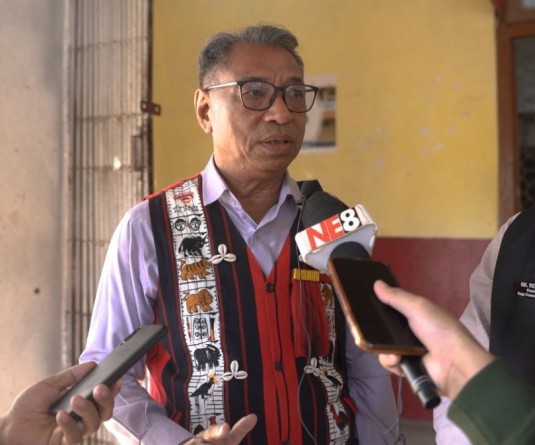
Participants at the State Level Sensitsation Workshop on Socio-Economic Caste Census 2011 (SECC) on September 20 at Kohima. (DIPR Photo)
Kohima, September 20 (DIPR): Nagaland will start the Socio-Economic Caste Census 2011 with effect from November 1 to 30, 2011 with a total of 133 Charge Centres-114 in the rural area and 19 under urban.
This was stated by Additional Chief Secretary & Commissioner, Nagaland, Banuo Z. Jamir IAS while delivering the introductory note at the State Level Sensitsation Workshop on Socio-Economic Caste Census 2011 (SECC) today the September 20 at the Conference Hall of the Directorate of Rural Development Kohima.
Highlighting on the concept and principles of SECC, Banuo informed that SECC will use three (3) set of parameters for identification of BPL population like automatic inclusion, automatic exclusion and ranking of households based on seven (7) deprivation indication. The information generated through this census will provide the ‘Who’ of population and will supplement the estimates available with the Planning Commission of the percentage of the rural and urban poor living below poverty line in the country, she observed and further viewed that SECC 2011 would address the shortcomings of the BPL survey of 2002 and will help target government schemes to the right beneficiaries and ensure that all beneficiaries are covered while ineligible beneficiaries are excluded. The Socio-Economic and Caste Census is being conducted in both rural and urban areas, with effect from June to December 2011, through a comprehensive door to door enumeration.
Banuo Z. Jamir said that the objective of the Census is to rank households based on their socio-economic status and to enable preparation of the list of families living below the poverty line, to generate authentic caste-wise (tribe-wise) population information in the country, to make available authentic information of the socio-economic condition and education status of various castes and sections of the population.
She further informed that the methodology for conduct of SECC 2011 was conceptualised and finalised on the recommendations of Expert Committees headed by Dr. N. Saxena of the Ministry of Rural Development and Professor SR Hussain for the urban areas, constituted by the Planning Commission. The methodology of SECC 2011 has been pilot tested in 254 villages across the country and will be conducted in 24 lakh enumeration blocks with each EB consisting of roughly 125-150 households, which was carved out during Census 2011, she further informed.
Emphasising on the importance of accurate data, the Additional Chief Secretary & Commissioner Nagaland said the challenging tasks of conducting SECC 2011 in the State will depends most largely on the Deputy Commissioners, as the Principal SECC 2011 officers. “The State Government is proud of the performance of all the officers and support teams in the districts in conducting the census 2011 with such determination and courage to bring out an honest and correct census and we look for similar performance in SECC 2011 as well”. The Government in various departments and officers will stand by you in your effort, she encouraged.
Reminding that the responsibility for giving accurate data lies on each and everyone to equip themselves with the right information to be disseminated to the people for the task in hand, Banuo requested all the DCs to be personally involved in the SECC 2011 exercise as much as in all other aspects of the programme.
Director R.D. Metsubo Jamir highlighted on the introduction, objective, process, eligibility and other information relating to SECC 2011 with a power point presentation. Director Urban Development Department also enlightened the gathering focusing on the progress made by Urban Development department, Rationale behind SECC-Urban, highlights of SECC-Urban, duties and responsibilities of District Nodal Officers, SECC-Urbans Abstract, through power point presentation.
Commissioner & Secretary RD, Department, V. Sakhrie chaired the morning sessions while Secretary Department of Urban Development, Neihu C. Thur IAS proposed the vote of thanks.
This was stated by Additional Chief Secretary & Commissioner, Nagaland, Banuo Z. Jamir IAS while delivering the introductory note at the State Level Sensitsation Workshop on Socio-Economic Caste Census 2011 (SECC) today the September 20 at the Conference Hall of the Directorate of Rural Development Kohima.
Highlighting on the concept and principles of SECC, Banuo informed that SECC will use three (3) set of parameters for identification of BPL population like automatic inclusion, automatic exclusion and ranking of households based on seven (7) deprivation indication. The information generated through this census will provide the ‘Who’ of population and will supplement the estimates available with the Planning Commission of the percentage of the rural and urban poor living below poverty line in the country, she observed and further viewed that SECC 2011 would address the shortcomings of the BPL survey of 2002 and will help target government schemes to the right beneficiaries and ensure that all beneficiaries are covered while ineligible beneficiaries are excluded. The Socio-Economic and Caste Census is being conducted in both rural and urban areas, with effect from June to December 2011, through a comprehensive door to door enumeration.
Banuo Z. Jamir said that the objective of the Census is to rank households based on their socio-economic status and to enable preparation of the list of families living below the poverty line, to generate authentic caste-wise (tribe-wise) population information in the country, to make available authentic information of the socio-economic condition and education status of various castes and sections of the population.
She further informed that the methodology for conduct of SECC 2011 was conceptualised and finalised on the recommendations of Expert Committees headed by Dr. N. Saxena of the Ministry of Rural Development and Professor SR Hussain for the urban areas, constituted by the Planning Commission. The methodology of SECC 2011 has been pilot tested in 254 villages across the country and will be conducted in 24 lakh enumeration blocks with each EB consisting of roughly 125-150 households, which was carved out during Census 2011, she further informed.
Emphasising on the importance of accurate data, the Additional Chief Secretary & Commissioner Nagaland said the challenging tasks of conducting SECC 2011 in the State will depends most largely on the Deputy Commissioners, as the Principal SECC 2011 officers. “The State Government is proud of the performance of all the officers and support teams in the districts in conducting the census 2011 with such determination and courage to bring out an honest and correct census and we look for similar performance in SECC 2011 as well”. The Government in various departments and officers will stand by you in your effort, she encouraged.
Reminding that the responsibility for giving accurate data lies on each and everyone to equip themselves with the right information to be disseminated to the people for the task in hand, Banuo requested all the DCs to be personally involved in the SECC 2011 exercise as much as in all other aspects of the programme.
Director R.D. Metsubo Jamir highlighted on the introduction, objective, process, eligibility and other information relating to SECC 2011 with a power point presentation. Director Urban Development Department also enlightened the gathering focusing on the progress made by Urban Development department, Rationale behind SECC-Urban, highlights of SECC-Urban, duties and responsibilities of District Nodal Officers, SECC-Urbans Abstract, through power point presentation.
Commissioner & Secretary RD, Department, V. Sakhrie chaired the morning sessions while Secretary Department of Urban Development, Neihu C. Thur IAS proposed the vote of thanks.






